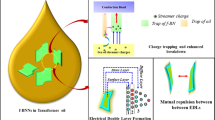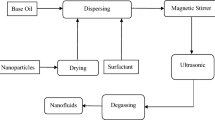Abstract
This paper presents some attractive properties of two-dimensional (2D) nanofillers based transformer oil (TO) nanofluids. Nanofluids of 2D hexagonal boron nitride (h-BN) nanosheets in TO show stable dispersion with improved dielectric breakdown strength and superior thermophysical properties like thermal conductivity, viscosity, and stability. A substantial augmentation in AC breakdown voltage (BDV) of TO with h-BN is observed, large compared to the state-of-the-art boron nitride (BN) particles. The enhancement in BDV is clarified by the role played by the larger oil-nanofiller interfacial regions also known as Maxwell-Garnet regions of 2D nanofillers in the context of charge trapping performance. The faster rate of heating and cooling and noteworthy enhancement in thermal conductivity agrees well with Maxwells forecasts. It is explained by the enhanced phonon transfer via the large oil-nanofiller interface of 2D nano additives. Finally, the natural electrostatic repulsion between the h-BN sheets at diluted concentration exhibited enhanced stability both with time and temperature variation compared to its particle counterpart and yielded in high thermal efficiency. Hence, 2D nanofillers are better choices for next generation surfactant free transformer oil nanofluids due to their high surface area, lower filler fraction and enhanced stability.









Similar content being viewed by others
References
Verma PP, Srinivasan D, Swarup KS, Mehta R (2018) A review of uncertainty handling techniques in smart grid. Int J Uncertain Fuzziness Knowledge-Based Syst 26(03):345–378. https://doi.org/10.1142/S0218488518500186
Qiu L, Zhu N, Feng Y, Michaelides EE, Żyła G, Jing D, Zhang X, Norris PM, Markides CN, Mahian O (2020) A review of recent advances in thermophysical properties at the nanoscale: from solid state to colloids. Phys Rep 843:1–81. https://doi.org/10.1016/j.physrep.2019.12.001
Ghoneim SS, Sabiha NA, Hessien MM, Alahmadi A (2019) Evaluation of dielectric breakdown strength of transformer oil with BaTiO3 and NiFe2O4 nanoparticles. Electr Eng 101(2):369–377. https://doi.org/10.1007/s00202-019-00788-8
Shukla G, Aiyer H (2015) Thermal conductivity enhancement of transformer oil using functionalized nanodiamonds. IEEE Trans Dielectr Electr Insul 22(4):2185–2190. https://doi.org/10.1109/TDEI.2015.004678
Primo VA, Garcia B, Albarracin R (2018) Improvement of transformer liquid insulation using nanodielectric fluids: a review. IEEE Electr Insul Mag 34(3):13–26. https://doi.org/10.1109/MEI.2018.8345357
Rafiq M, Lv Y, Li C, Sun Q (2020) Effect of Al2O3 nanorods on the performance of oil-impregnated pressboard insulation. Electr Eng 102(2):715–724. https://doi.org/10.1007/s00202-019-00907-5
Williams OA, Hees J, Dieker C, Jager W, Kirste L, Nebel CE (2010) Size-dependent reactivity of diamond nanoparticles. ACS Nano 4(8):4824–4830. https://doi.org/10.1021/nn100748k
Singh NB, Shukla SK (2020) Properties of two-dimensional nanomaterials. Two-Dimens Nanostructures Biomed Technol. https://doi.org/10.1016/B978-0-12-817650-4.00003-6
Du BX, Li XL, Xiao M (2015) High thermal conductivity transformer oil filled with BN nanoparticles. IEEE Trans Dielectr Electr Insul 22(2):851–858. https://doi.org/10.1109/TDEI.2015.7076784
Zhao G, Zhang F, Wu Y, Hao X, Wang Z, Xu X (2016) One-Step exfoliation and hydroxylation of boron nitride nanosheets with enhanced optical limiting performance. Adv Opt Mater. https://doi.org/10.1002/adom.201500415
Bhunia MM, Panigrahi K, Das S, Chattopadhyay KK, Chattopadhyay P (2018) Amorphous graphene–transformer oil nanofluids with superior thermal and insulating properties. Carbon 139:1010–1019. https://doi.org/10.1016/j.carbon.2018.08.012
Mangaud E, Bocquet ML, Bocquet L, Rotenberg B (2022) Chemisorbed vs physisorbed surface charge and its impact on electrokinetic transport: Carbon vs boron nitride surface. J Chem Phys 156(4):044703. https://doi.org/10.1016/j.solener.2014.03.013
Grosjean B, Pean C, Siria A, Bocquet L, Vuilleumier R, Bocquet ML (2016) Chemisorption of hydroxide on 2D materials from DFT calculations: graphene versus hexagonal boron nitride. J Phys Chem Lett 7(22):4695–4700. https://doi.org/10.1021/acs.jpclett.6b02248
Laturia A, Van de Put ML, Vandenberghe WG (2018) Dielectric properties of hexagonal boron nitride and transition metal dichalcogenides: from monolayer to bulk. npj 2D Mater Appl. 2(1):1–7
Jin H (2015) Dielectric strength and thermal conductivity of mineral oil based nanofluids. Dissertation, Delft University of Technology
Farade RA, Wahab NI, Mansour DE, Azis NB, Jasni JB, Veerasamy V, Vinayagam A, Kotiyal BM, Khan TY (2021) The effect of interfacial zone due to nanoparticle-surfactant interaction on dielectric properties of vegetable oil based nanofluids. IEEE Access 9:107033–107045. https://doi.org/10.1109/ACCESS.2021.3098758
Bhunia MM, Panigrahi K, Naskar CB, Bhattacharjee S, Chattopadhyay KK, Chattopadhyay P (2021) 2D square nanosheets of Anatase TiO2: A surfactant free nanofiller for transformer oil nanofluids. J of Mol Liq 325:115000. https://doi.org/10.1016/j.molliq.2020.115000
Joni IM, Balgis R, Ogi T, Iwaki T, Okuyama K (2011) Surface functionalization for dispersing and stabilizing hexagonal boron nitride nanoparticle by bead milling. Colloids Surf A Physicochem Eng Asp 388(1–3):49–58. https://doi.org/10.1016/j.colsurfa.2011.08.007
Fasehullah M, Wang F, Jamil S (2022) Significantly elevated AC dielectric strength of synthetic ester oil-based nanofluids by varying morphology of CdS nano-additives. J Mol Liq 353:118817. https://doi.org/10.1016/j.molliq.2022.118817
Li M, Huang G, Chen X, Yin J, Zhang P, Yao Y, Shen J, Wu Y, Huang J (2022) Perspectives on environmental applications of hexagonal boron nitride nanomaterials. Nano Today 44:101486. https://doi.org/10.1016/j.nantod.2022.101486
Zehri A, Nylander A, Nilsson TM, Ye L, Fu Y, Liu J (2022) Graphene oxide and nitrogen-doped graphene coated copper nanoparticles in water-based nanofluids for thermal management in electronics. J Nanofluids 11(1):125–134. https://doi.org/10.1166/jon.2022.1816
Das AK, Chatterjee S (2018) Analysis of thermophoresis and Brownian motion effect in heat transfer for nanofluid immersed distribution transformer. Electr Eng 100(3):1963–1974. https://doi.org/10.1007/s00202-017-0676-2
Gupta A, Kumar R (2007) Role of Brownian motion on the thermal conductivity enhancement of nanofluids. Appl Phys 91(22):223102. https://doi.org/10.1063/1.2816903
Wu K, Cheng C (2017) Interface charges between insulating materials. IEEE Trans Dielectr Electr Insul 24(4):2633–2642. https://doi.org/10.1109/TDEI.2017.006442
Alexeev D, Chen J, Walther JH, Giapis KP, Angelikopoulos P, Koumoutsakos P (2015) Kapitza resistance between few-layer graphene and water: liquid layering effects. Nano lett 15(9):5744–5749. https://doi.org/10.1021/acs.nanolett.5b03024
Cai Q, Scullion D, Gan W, Falin A, Zhang S, Watanabe K, Taniguchi T, Chen Y, Santos EJ, Li LH (2019) High thermal conductivity of high-quality monolayer boron nitride and its thermal expansion. Sci adv 5(6):eaav0129. https://doi.org/10.1126/sciadv.aav0129
Maharana M, Bordeori MM, Nayak SK, Sahoo N (2018) Nanofluid-based transformer oil: effect of ageing on thermal, electrical and physicochemical properties. IET Sci Meas Technol 12(7):878–885. https://doi.org/10.1049/iet-smt.2017.0475
Parvar M, Saedodin S, Rostamian SH (2020) Experimental study on the thermal conductivity and viscosity of transformer oil-based nanofluid containing ZnO nanoparticles. J Heat and Mass Trans Res 7(1):77–84. https://doi.org/10.22075/JHMTR.2020.19303.1267
Amiri A, Kazi SN, Shanbedi M, Zubir MN, Yarmand H, Chew BT (2015) Transformer oil based multi-walled carbon nanotube–hexylamine coolant with optimized electrical, thermal and rheological enhancements. Rsc Adv 5(130):107222–107236. https://doi.org/10.1039/C5RA17687E
Prasher R, Song D, Wang J, Phelan P (2006) Measurements of nanofluid viscosity and its implications for thermal applications. App Phy Lett 89(13):133108. https://doi.org/10.1063/1.2356113
Mahesh KV, Linsha V, Mohamed AP, Ananthakumar S (2016) Processing of 2D-MAXene nanostructures and design of high thermal conducting, rheo-controlled MAXene nanofluids as a potential nanocoolant. Chem Eng J 297:158–169. https://doi.org/10.1016/j.cej.2016.04.010
Esfe MH, Hajmohammad MH (2017) Thermal conductivity and viscosity optimization of nanodiamond-Co3O4/EG (40: 60) aqueous nanofluid using NSGA-II coupled with RSM. J of Mol Liq 238:545–552. https://doi.org/10.1016/j.molliq.2017.04.056
Atiya EG, Mansour DE, Khattab RM, Azmy AM (2015) Dispersion behavior and breakdown strength of transformer oil filled with TiO2 nanoparticles. IEEE Trans Dielectr Electr Insul 22(5):2463–2472. https://doi.org/10.1109/TDEI.2015.004742
Afshari F, Manay E, Rahimpour S, Sahin B, Muratçobanoglu B, Teimuri-Mofrad R (2022) A review study on factors affecting the stability of nanofluids. Heat Trans Res. https://doi.org/10.1615/HeatTransRes.2022041979
Madavan R, Kumar SS, Iruthyarajan MW (2018) A comparative investigation on effects of nanoparticles on characteristics of natural esters-based nanofluids. Colloids Surf A: Physicochem Eng Asp 556:30–36. https://doi.org/10.1016/j.colsurfa.2018.08.014
Yao W, Huang Z, Li J, Wu L, Xiang C (2018) Enhanced electrical insulation and heat transfer performance of vegetable oil based nanofluids. J Nanomater. https://doi.org/10.1155/2018/4504208
Acknowledgements
Authors gratefully acknowledge the financial support of CPRI, Bangalore, Govt. of India, and Ministry of Power to carry out this research work under NPP scheme. Authors also wish to thank, TEQIP—II, for the instrumental support for performing characterization. Help and assistance render from Dr. Swati Das, of Anandamohan College, in the synthesis of nanomaterials at initial stage of the NPP project, are thankfully acknowledged. Authors are also indebted to the contribution of Dr. Nirmala Sankar Das for his sincere effort towards the graphics of this paper. Karamjyoti Panigrahi is thanked for his valuable suggestions, editing and idea regarding the manuscript revision.
Author information
Authors and Affiliations
Corresponding author
Ethics declarations
Conflict of interest
Authors declare that there is no conflict of interests.
Additional information
Publisher's Note
Springer Nature remains neutral with regard to jurisdictional claims in published maps and institutional affiliations.
Rights and permissions
Springer Nature or its licensor (e.g. a society or other partner) holds exclusive rights to this article under a publishing agreement with the author(s) or other rightsholder(s); author self-archiving of the accepted manuscript version of this article is solely governed by the terms of such publishing agreement and applicable law.
About this article
Cite this article
Bhunia, M.M., Chattopadhyay, K.K. & Chattopadhyay, P. Transformer oil nanofluids by two-dimensional hexagonal boron nitride nanofillers. Electr Eng 105, 813–825 (2023). https://doi.org/10.1007/s00202-022-01699-x
Received:
Accepted:
Published:
Issue Date:
DOI: https://doi.org/10.1007/s00202-022-01699-x




